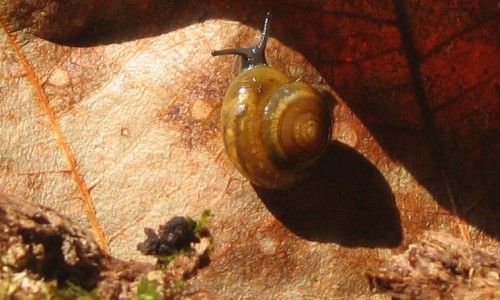When strolling through the forest, your attention might be drawn to bird songs in the canopy, whiffs of fragrant wildflowers, and the sight of animal tracks. What happens if we spend time looking for the less obvious animals, some of which might exist right under our hiking boots? Let’s peer into the leaf litter to look.
Slow down, observe carefully, and you’ll be rewarded with a glimpse into the secret world of land snails.
Snails carry an unjustly poor reputation due to the invasive snails that damage crops and frustrate gardeners. Invasive snails arrived here accidentally from other countries. But did you know that there are around 115 species of land snails in New York State alone, and around 1,000 species in North America, and the vast majority are native and actually beneficial to the ecosystem?
Unlike invasive snails that ruin our prized plants, native land snails occupy an important position in the food web: near the bottom. Native land snails’ diets consist of fungi and decaying vegetation, hence they serve as cleanup crews of the ecosystem. Gleaning calcium and other vital nutrients from decomposing matter, they in turn become an important food for so many animals, including many species of insects, amphibians, reptiles, birds, and mammals.
Land snails are mollusks, a group that includes snails of the sea, clams, octopus, and squid. Land snails breathe air; their distant marine and freshwater snail cousins breathe through gills. Well adapted to life on land, snails have a protective shell and mucus secreted by their skin. Mucus, or slime, as it’s often called, helps maintain adequate fluids in the snail’s body. Land snails live in damp places – in leaf litter, under old logs, and in the top layer of soil – perfectly moist microhabitats.
Most land snail species in our area are tiny, measuring no more than 5 millimeters (one-fifth of an inch) at the greatest width of the shell. In fact, many species are extremely tiny, measuring just 1 or 2 millimeters, or about the size of a pinhead! For this reason, many people don’t realize that there’s a world of teeny animals underfoot.
Land snails are generally hermaphroditic, that is, they possess both male and female reproductive organs. When they mate, snails fertilize each other’s eggs with sperm, and then each lays a clutch of eggs. Our native snails lay between three and 50 eggs per clutch.
Snail embryos develop within the eggs over a few weeks. When they hatch, the shell has one single whorl, and as the young snail grows, the shell grows with it, in spiral form around a central point. Snails can’t leave their shells, just as we can’t leave our fingernails.
Did you know that slugs are snails too, only minus the shell? Slugs evolved adaptations for survival without a shell, such as producing thicker, gooier mucus than snails do, maintaining moisture and repelling predators.
And within snails’ and slugs’ bodies are systems not unlike our own. They have a digestive tract, kidney, lung, and a two-chambered heart. Find a translucent-shelled snail and you can even see its heart beating through the shell. Even those teeny, pinhead sized snails have a beating heart… a very teeny heart, of course.
Two sets of tentacles on the snail’s head help them to find their way, food, and each other. The longer, upper pair are equipped with three different senses: vision, olfactory, and touch. The lower pair are for olfactory and touch.
Within the snail’s mouth is a chitinous, ribbon-like structure called a radula. Lined with thousands of tiny teeth arranged neatly in rows and columns, the radula acts as a file, to rasp the food of the snail.
Despite fabulous adaptations to land, snails are among the most sensitive animals to pollutants, including road runoff and acidic rainfall. Land snail populations have dwindled in recent decades, in turn contributing to the decline of certain bird species. When we think of animal and ecosystem conservation, we should include land snails.
The next time you walk through the woods, take the time to slow down, sift through the leaf litter, and find some snails to appreciate. Even when you can’t see them, you’ll know there are thousands of tiny hearts beating throughout the forest.


